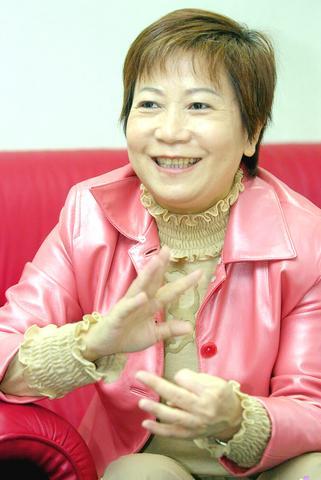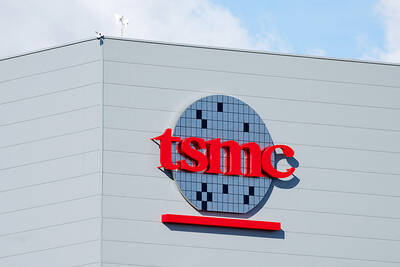Taipei Times: Can you talk about the changes in the fitness market over the past 20 years?
Pure Tsai (蔡純真): When I opened my first center in Taipei, people in Taiwan generally had no concept of exercising or maintaining their figure in fitness facilities. Therefore, I advocated exercise and fitness with my home videos at that time.
It was really tough at the beginning. It was not until the past five or six years that the industry has started to take off. People living in the cities started to seek exercise to release pressure but found no space to work out in. Aside from the health issues, people want to maintain their figures to make themselves look good, which also helps boost the industry.

PHOTO: CHIANG YING-YING, TAIPEI TIMES
Based on my observations, the customers also extended from women to men, from middle age working class to the younger generation. Now that the business pie is becoming bigger, fitness center operators tend to target different consumers.
For example, we focus on high-incomes consumers between 25 and 65 years old with our roomy and exquisite centers, while others target younger generation with entertainment facilities.
TT: As the number of gym-goers has increased in Taiwan, many companies have been plunging into this market. From your viewpoint, has this market saturated already? If not, how much further can it grow?
Tsai: As I see it, the market is far from saturated even with many players in the market. I expect one out of four adults to join a fitness club, while currently we are only at 1 percent in the Taipei region. This shows that the market has great potential. I'm pretty optimistic about it.
According to one of our surveys, consumers in Taiwan with monthly salaries of NT$35,000 or above are willing to pay NT$2,000 to NT$8,000 a month to lose weight or improve their figures. But before we can garner all our target customers, we still focus on improving our service quality to satisfy our current members.
TT: As a forerunner in this industry, how are you going to compete with entries that are rapidly expending to erode your market share?
Tsai: We never tried to compete with them. As I said earlier, the fitness clubs in Taiwan tend to target different groups, so our membership numbers did not drop due to the new competitors. In fact, their joining the sector has instead helped spur a sporting trend here, which drives the industry by attracting more people to come to the gyms.
I still remember when I first started my business, I needed to spend a lot of time introducing my products and service, as well as explaining to potential customers why they needed us.
But we don't need to put in that much effort now, as people already have a general awareness of who we are and what we would offer. As a result, we now focus on advancing our service to maintain our long-standing reputation.
TT: Your Youth Camp Health Group recently got a lot of media attention with the luxurious 1,700-ping Oxy Gym (氧身運動館) to be opened in March in the Taipei 101 Mall, which aims to collect 101 VIP members with a stunning annual fee of NT$1.01 million aside from ordinary members. How did you come up with such an idea in the first place and has the goal been reached yet?
Tsai: As a veteran in this area for over 20 years, I figured out that many entrepreneurs and industrialists barely have time to exercise, let alone conduct health management themselves. With this program, we provide physical training, health management classes, massage, therapy, nutritionists' homemade health food and other services. We require them to come to our class at least twice a month. The initial response to our program has been very positive as we've collected 70 members so far. We will open the registration for the rest of the quota when we launch the store. I am confident that the quota will be filled soon as many have approached me regarding obtaining the VIP membership.
TT: Currently, fitness centers in Taiwan are concentrated in major cities like Taipei, Taichung and Kaohsiung. Will you consider opening outlets in other areas in the nation?
Tsai: We will open our Taichung and Kaohsiung outlets, aiming to absorb 2,500 and 4,000 members respectively in the next one to two years. We have no plan to exploit rural areas as people there have no strong needs for fitness or pressure reduction compared to city inhabitants. Besides, people living in rural areas tend to exercise outdoors rather than in gyms.
TT: As is the case in many industries, companies tend to wage price wars during times of fierce competition, but this often results in a decline in quality. Will this phenomenon also happen in the fitness industry?
Tsai: It's already happening. As other companies in this industry seek to quickly expand in a short time to gain market share, they have slashed prices to half or even one-third of the amount we charge. To meet the demand from the surging member numbers and save costs at the same time, they hire unqualified gym coaches or give insufficient training. The boost in membership also makes the gyms packed with customers waiting for their turns to use the fitness facilities. As you see, some customer disputes have occurred in some companies.
I think this is by far the largest obstacle to the continued development of this sector. If the problem can't be improved, the industry may soon disappear if consumers lose confidence in us. Therefore, I have tried not to join the price war to maintain the quality we have long been upholding.
TT: Besides the domestic market, the fitness business war seems to have extended to China, with some companies unveiling plans to cross the Taiwan Strait. Do you have a similar project in mind?
Tsai: We have no plans to open outlets across the Taiwan Strait so far. Many Taiwanese businessmen always want to duplicate their success in the domestic market in China without considering many factors.
My observation of the Chinese market, especially in big cities like Shanghai, is that Taiwanese companies, even other foreign rivals, can't compete with their Chinese counterparts in terms of their knowledge about the Chinese market and business strategies for that market.
I believe many Taiwanese companies have reckoned that they won't rake in profits as soon as they enter the Chinese market. They just want to gain a foothold there ahead of other competitors in the hope of reaping some profits despite losing money initially.
Under such circumstances, we won't go head-to-head with them. However, we can be an upstream supplier for them. As their fitness industry is in a rudimentary phase, they need our know-how to help develop the sector. My plan is to set up an education and marketing center there soon, as well as bringing our health-care products to local fitness centers.
TT: Do you think it is a good time to enter the Chinese market given the comparatively low purchasing power?
Tsai: I don't think the Chinese market is ready for the fitness industry. China is a developing country so people there are concentrating on making more money like Taiwanese people 20 years ago. They generally put finance ahead of health and figure issues. I figured out that although there are also a large number of people joining fitness clubs, they only use their memberships to show off. We also probed business opportunities from China-bound Taiwanese businesspeople, but most said they'd rather spend the time to come back to Taiwan than in the gym. Therefore, I think it will take a lot longer for China to turn into a mature consumer market.
TT: What are your short-term and long-term goals for the company or the industry?
Tsai: For this year, I plan to open four more Oxy Gyms and some spa parlors in the Taipei region to meet demand. I also hope to reach the goals we have set for our yet-to-be opened Taichung and Kaohsiung stores.
As for the overseas market, we are planning to bring our service to overseas Chinese, first in New York City. From my experience in marketing in various foreign markets, I found overseas Chinese have a high recognition of our brand name and products as most of our products are made especially for Asians. In the long run, we'll still run under our core business model and make proper modifications to cater to trends and customer needs.
As the local fitness market is entering a chaotic period, I would also like to provide my expertise to assist them, which will also help to prolong the industry.

Taiwan Semiconductor Manufacturing Co (TSMC, 台積電) secured a record 70.2 percent share of the global foundry business in the second quarter, up from 67.6 percent the previous quarter, and continued widening its lead over second-placed Samsung Electronics Co, TrendForce Corp (集邦科技) said on Monday. TSMC posted US$30.24 billion in sales in the April-to-June period, up 18.5 percent from the previous quarter, driven by major smartphone customers entering their ramp-up cycle and robust demand for artificial intelligence chips, laptops and PCs, which boosted wafer shipments and average selling prices, TrendForce said in a report. Samsung’s sales also grew in the second quarter, up

LIMITED IMPACT: Investor confidence was likely sustained by its relatively small exposure to the Chinese market, as only less advanced chips are made in Nanjing Taiwan Semiconductor Manufacturing Co (TSMC, 台積電) saw its stock price close steady yesterday in a sign that the loss of the validated end user (VEU) status for its Nanjing, China, fab should have a mild impact on the world’s biggest contract chipmaker financially and technologically. Media reports about the waiver loss sent TSMC down 1.29 percent during the early trading session yesterday, but the stock soon regained strength and ended at NT$1,160, unchanged from Tuesday. Investors’ confidence in TSMC was likely built on its relatively small exposure to the Chinese market, as Chinese customers contributed about 9 percent to TSMC’s revenue last

With this year’s Semicon Taiwan trade show set to kick off on Wednesday, market attention has turned to the mass production of advanced packaging technologies and capacity expansion in Taiwan and the US. With traditional scaling reaching physical limits, heterogeneous integration and packaging technologies have emerged as key solutions. Surging demand for artificial intelligence (AI), high-performance computing (HPC) and high-bandwidth memory (HBM) chips has put technologies such as chip-on-wafer-on-substrate (CoWoS), integrated fan-out (InFO), system on integrated chips (SoIC), 3D IC and fan-out panel-level packaging (FOPLP) at the center of semiconductor innovation, making them a major focus at this year’s trade show, according

DEBUT: The trade show is to feature 17 national pavilions, a new high for the event, including from Canada, Costa Rica, Lithuania, Sweden and Vietnam for the first time The Semicon Taiwan trade show, which opens on Wednesday, is expected to see a new high in the number of exhibitors and visitors from around the world, said its organizer, SEMI, which has described the annual event as the “Olympics of the semiconductor industry.” SEMI, which represents companies in the electronics manufacturing and design supply chain, and touts the annual exhibition as the most influential semiconductor trade show in the world, said more than 1,200 enterprises from 56 countries are to showcase their innovations across more than 4,100 booths, and that the event could attract 100,000 visitors. This year’s event features 17